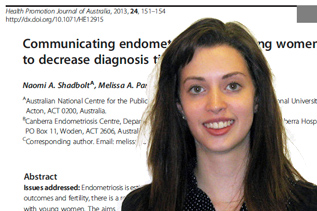Communicating about endometriosis with young women

Communicating health information is always challenging, but communicating about a disease that is hard to diagnose and involves social taboos is extra difficult.
Endometriosis is a painful and debilitating illness affecting women of menstrual age, in which uterine tissue grows outside the uterus, sometimes affecting fertility as well as causing serious pain. It is thought to affect approximately 10% of women, but it is difficult to diagnose definitively without invasive surgery.
Although early detection can enhance health outcomes, women with endometriosis often don't find out they have it until later in life. There are a number of reasons for this, including fear and discomfort talking about reproductive and sexual health, particularly about menstruation. Many young women with endometriosis will suffer through painful periods without consulting a doctor, believing there's nothing that can be done. But this prolongs the agony longer than necessary and can create other complications.
Until now, the majority of endometriosis information and support has been directed at older women, but researchers at the Australian National Centre for the Public Awareness of Science (CPAS) and the Canberra Endometriosis Centre argue that raising awareness of the illness among young women may lead to earlier diagnoses, and improve women's health.
In 2011, undergraduate science communication student Naomi Shadbolt conducted a survey of 131 women from the Canberra region aged 16-25 to find out what they knew about endometriosis, what they wanted to know and how they wanted to access that information. The results of the project were published in a paper in the Health Promotion Journal of Australia in October 2013. Ms Shadbolt was jointly supervised by Melissa Parker from the Canberra Endometriosis Centre and Lindy Orthia from CPAS, both of whom co-authored the paper.
The punchline of the study was that young women want to know more about endometriosis, and believe they should be learning about it as teenagers.
About half the women surveyed had heard of endometriosis, but 89% thought teenagers should be educated about it, and 78% thought men should also know about it. The majority preferred to find out about it through schools (40%), the internet (22%) or magazines (13%), and felt most comfortable talking about it with doctors (75%), parents (59%) or friends (51%).
"This is the first time researchers have specifically asked young women for their thoughts on endometriosis communication," said Ms Parker. "It's research that's long overdue."
Ms Parker and the Canberra Endometriosis Centre are currently working on endometriosis information programs to run through schools and on the internet.
Ms Shadbolt continues to work in the health promotion research area, in 2013 conducting a study of ANU students about their health-related behaviours, attitudes and knowledge, in her capacity as a Master of Science Communication student.
